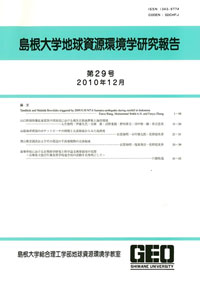島根大学総合理工学部地球資源環境学教室
ISSN:1343-9774

number of downloads : ?
Use this link to cite this item : https://ir.lib.shimane-u.ac.jp/6123
Geoscience reports of Shimane University 22
2003-12-27 発行
隠岐島後中央部の下部中新統の郡層について
On the lower Miocene Kori Formation,central Oki-Dogo lsland,Japan Sea.
Ochiai, Toshio
Yamauchi, Seiki
Murakami, Hisashi
File
Description
A latest Oligocene to late Miocene succession is widely distributed over the Oki Gneiss on Oki-Dogo island in the southern Sea of Japan.It is divided into the Tokibariyama,Kori,Kumi,and Tsuma Formations,and is overlies by the Oki Alkali Volcanics of latest Miocene age.This paper reexamines the a geological structure and depositional environment of the Kori Formation and its relationship with the over-and under-lying beds in central Oki−Dogo.
Previous work inferred the Kori Formation in the study area contacts the underlying Tokibariyama Formation along NE-SW faults.However,Kori Formation generally unconfomably overlies Tokibariyama Formation an undulating surface.
The steeply dipping surface of the unconformity between the formations indicates that the Kori sedimentary basin formed by faulting of the Tokibariyama Formation.The Kori Formation is also folded along a N-S axis nearly parallel with the Koji River in the northern part of the study area,and rapidly thickens westward reaching a thickness of more than 1200m.
The unit known as the Hei Memder has previously been regarded as the lowermost part of the Kumi Formation,and is thought to be the first marine sediment on Oki-Dogo.However,we found that the Utagi Member of the Kumi Formation discordantly overlies and erodes the Hei Member.These relations indicate that the Hei Member should therefore be regarded as the uppermost unit the Kori Formation,ratherthan the base of the Kumi Formation.
Total sulfur,total organic carbon and total nitrogen analyses of mudstones of Tokibariyama and Kori formations indicate that temporally marine transgression occurred in about the middle of the Kori stage,at about 18 or 17 Ma
Previous work inferred the Kori Formation in the study area contacts the underlying Tokibariyama Formation along NE-SW faults.However,Kori Formation generally unconfomably overlies Tokibariyama Formation an undulating surface.
The steeply dipping surface of the unconformity between the formations indicates that the Kori sedimentary basin formed by faulting of the Tokibariyama Formation.The Kori Formation is also folded along a N-S axis nearly parallel with the Koji River in the northern part of the study area,and rapidly thickens westward reaching a thickness of more than 1200m.
The unit known as the Hei Memder has previously been regarded as the lowermost part of the Kumi Formation,and is thought to be the first marine sediment on Oki-Dogo.However,we found that the Utagi Member of the Kumi Formation discordantly overlies and erodes the Hei Member.These relations indicate that the Hei Member should therefore be regarded as the uppermost unit the Kori Formation,ratherthan the base of the Kumi Formation.
Total sulfur,total organic carbon and total nitrogen analyses of mudstones of Tokibariyama and Kori formations indicate that temporally marine transgression occurred in about the middle of the Kori stage,at about 18 or 17 Ma
Other Article
PP. 1 - 14
PP. 67 - 74
PP. 75 - 80
PP. 93 - 105
PP. 107 - 110
PP. 111 - 120
PP. 121 - 133
PP. 141 - 148
PP. 149 - 160
PP. 161 - 166
PP. 167 - 172
